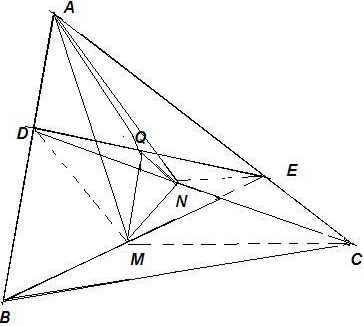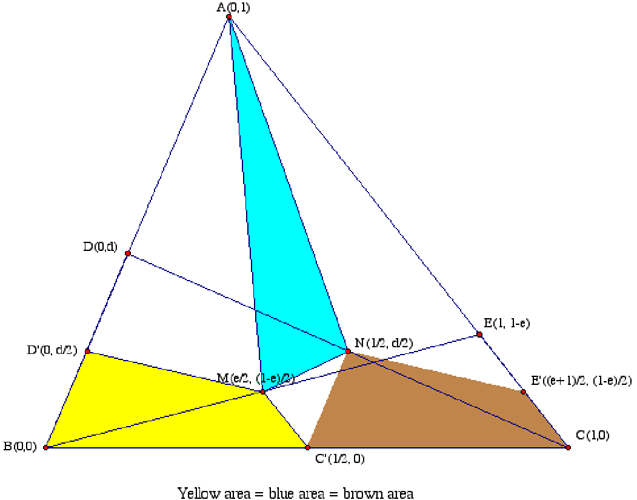| |||
| Math Central | Quandaries & Queries |
|
Question from Shamik, a student: ABC is any triangle and D and E are 2 points on AB and AC, respectively. M Use plane-geometry without using co-ordinates to find the solution. My Work Done: This can be achieved if I use analytical geometry with the help of A' ? midpoint of BC A'N = (1/2)*BD I thought a lot in the above lines but couldn't meet the solution. I have If I could consider one more mid-point somewhere in the diagram. If I could Thanks |
Chris responded with a proof that uses coordinates and then Shamik produced his own proof. We have Shamik's proof first and then Chris'.
Please, refer to the figure. Here is the solution.

Let Q be the midpoint of DE. Join QA, QM, QN, MD, MC and NE.
Triangle (AMN) = Triangle (AMQ) + Triangle (QMN) + Triangle (QNA)
Q, M and N are midpoints of DE, BE and CD, respectively. Therefore, QM is parallel to AB and QN is parallel to AC.
And, hence, Triangle (AQM) = Triangle (DQM) and Triangle (AQN) = Triangle (EQN)
So, Triangle (AMN) = Triangle (AQM) + Triangle (QMN) + Triangle (QNA)
= Triangle (DQM) + Triangle (QMN) + Triangle (EQN)
Thus, Triangle (AMN) = Quadrilateral (DMNE) ………………. (1)
M is the midpoint of BE and so Triangle (DME) = (1/2)* Triangle (BDE) while Triangle (CME) = (1/2)* Triangle (BCE)
è Triangle (DME) + Triangle (CME) = (½)*{Triangle (BDE) + Triangle (BCE))
è Quadrilateral (DMCE) = (1/2)*Quadrilateral (DBCE)
Similarly, Quadrilateral (DMNE) = (1/2)*{Quadrilateral (DMCE)} = (1/4)*{Quadrilateral (DBCE)} ……. (2)
From (1) and (2) we get, Triangle (AMN) = (1/4)*{Quadrilateral (DBCE)}
Shamik
Chris' proof
We simplified the problem a bit by first shrinking the quadrilateral BCED by ½: Take C' and D' the midpoints of BC and BD, then show that (AMN) = Area(BC'MD'). Using the coordinates shown in the figure, we compute
and
Was your argument this easy? We will let you know if we find a simple argument that avoids coordinates.

Chris
 |
||
Math Central is supported by the University of Regina and The Pacific Institute for the Mathematical Sciences.

